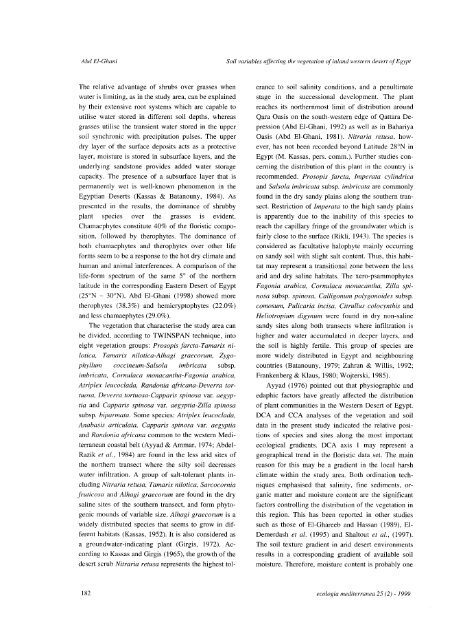Ecologia mediterranea 1999-25(2)
Ecologia mediterranea 1999-25(2)
Ecologia mediterranea 1999-25(2)
Create successful ePaper yourself
Turn your PDF publications into a flip-book with our unique Google optimized e-Paper software.
Abd El-Ghani Soil variables affecting the vegetation ofinland western desert ofEgypt<br />
The relative advantage of shrubs over grasses when<br />
water is limiting, as in the study area, can be explained<br />
by their extensive root systems which are capable to<br />
utilise water stored in different soil depths, whereas<br />
grasses utilise the transient water stored in the upper<br />
soil synchronic with precipitation pulses. The upper<br />
dry layer of the surface deposits acts as a protective<br />
layer, moisture is stored in subsurface layers, and the<br />
underlying sandstone provides added water storage<br />
capacity. The presence of a subsurface layer that is<br />
permanently wet is well-known phenomenon in the<br />
Egyptian Deserts (Kassas & Batanouny, 1984). As<br />
presented in the results, the dominance of shrubby<br />
plant species over the grasses is evident.<br />
Chamaephytes constitute 40% of the floristic compo<br />
sition, followed by therophytes. The dominance of<br />
both chamaephytes and therophytes over other life<br />
forms seem to be a response to the hot dry climate and<br />
human and animal interferences. A comparison of the<br />
life-form spectrum of the same 5° of the northern<br />
latitude in the corresponding Eastern Desert of Egypt<br />
(<strong>25</strong>°N - 30 0<br />
N), Abd EI-Ghani (1998) showed more<br />
therophytes (38.3%) and hemicryptophytes (22.0%)<br />
and less chamaephytes (29.0%).<br />
The vegetation that characterise the study area can<br />
be divided, according to TWINSPAN technique, into<br />
eight vegetation groups: Prosopis farcta-Tamarix nilotica,<br />
Tamarix nilotica-Alhagi graecorum, Zygo<br />
phyllum coccineum-Salsola imbricata subsp.<br />
imbricata, Cornulaca monacantha-Fagonia arabica,<br />
Atriplex leucoclada, Randonia africana-Deverra tor<br />
tuosa, Deverra tortuosa-Capparis spinosa var. aegyp<br />
tia and Capparis spinosa var. aegyptia-Zilla spinosa<br />
subsp. biparmata. Some species: Atriplex leucoclada,<br />
Anabasis articulata, Capparis spinosa var. aegyptia<br />
and Randonia africana common to the western Medi<br />
terranean coastal belt (Ayyad & Ammar, 1974; Abdel<br />
Razik et aI., 1984) are found in the less arid sites of<br />
the northern transect where the silty soil decreases<br />
water infiltration. A group of salt-tolerant plants in<br />
cluding Nitraria retusa, Tamarix nilotica, Sarcocornia<br />
fruticosa and Alhagi graecorum are found in the dry<br />
saline sites of the southern transect, and form phyto<br />
genic mounds of variable size. Alhagi graecorum is a<br />
widely distributed species that seems to grow in dif<br />
ferent habitats (Kassas, 1952). It is also considered as<br />
a groundwater-indicating plant (Girgis, 1972). According<br />
to Kassas and Girgis (1965), the growth of the<br />
desert scrub Nitraria retusa represents the highest tol-<br />
182<br />
erance to soil salinity conditions, and a penultimate<br />
stage in the successional development. The plant<br />
reaches its northernmost limit of distribution around<br />
Qara Oasis on the south-western edge of Qattara Depression<br />
(Abd EI-Ghani, 1992) as well as in Bahariya<br />
Oasis (Abd EI-Ghani, 1981). Nitraria retusa, how<br />
ever, has not been recorded beyond Latitude 28°N in<br />
Egypt (M. Kassas, pers. comm.). Further studies con<br />
cerning the distribution of this plant in the country is<br />
recommended. Prosopis farcta, Imperata cylindrica<br />
and Salsola imbricata subsp. imbricata are commonly<br />
found in the dry sandy plains along the southern tran<br />
sect. Restriction of Imperata to the high sandy plains<br />
is apparently due to the inability of this species to<br />
reach the capillary fringe of the groundwater which is<br />
fairly close to the surface (Rikli, 1943). The species is<br />
considered as facultative halophyte mainly occurring<br />
on sandy soil with slight salt content. Thus, this habi<br />
tat may represent a transitional zone between the less<br />
arid and dry saline habitats. The xero-psammophytes<br />
Fagonia arabica, Cornulaca monacantha, Zilla spi<br />
nosa subsp. spinosa, Calligonum polygonoides subsp.<br />
comosum, Pulicaria incisa, Citrullus colocynthis and<br />
Heliotropium digynum were found in dry non-saline<br />
sandy sites along both transects where infiltration is<br />
higher and water accumulated in deeper layers, and<br />
the soil is highly fertile. This group of species are<br />
more widely distributed in Egypt and neighbouring<br />
countries (Batanouny, 1979; Zahran & Willis, 1992;<br />
Frankenberg & Klaus, 1980; Wojterski, 1985).<br />
Ayyad (1976) pointed out that physiographic and<br />
edaphic factors have greatly affected the distribution<br />
of plant communities in the Western Desert of Egypt.<br />
DCA and CCA analyses of the vegetation and soil<br />
data in the present study indicated the relative posi<br />
tions of species and sites along the most important<br />
ecological gradients. DCA axis 1 may represent a<br />
geographical trend in the floristic data set. The main<br />
reason for this may be a gradient in the local harsh<br />
climate within the study area. Both ordination tech<br />
niques emphasised that salinity, fine sediments, or<br />
ganic matter and moisture content are the significant<br />
factors controlling the distribution of the vegetation in<br />
this region. This has been reported in other studies<br />
such as those of EI-Ghareeb and Hassan (1989), El<br />
Demerdash et al. (1995) and Shaltout et aI., (1997).<br />
The soil texture gradient in arid desert environments<br />
results in a corresponding gradient of available soil<br />
moisture. Therefore, moisture content is probably one<br />
ecologia <strong>mediterranea</strong> <strong>25</strong> (2) - <strong>1999</strong>

















